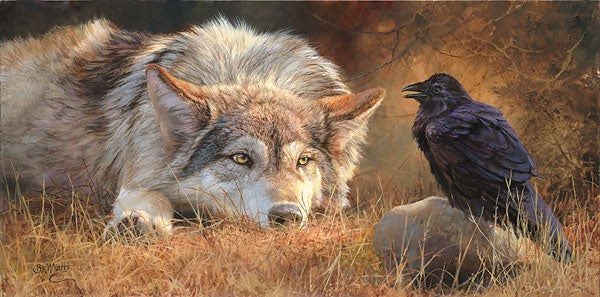After Odin and his two brothers Vili and Ve created Midgard and mankind, Odin decided to roam alone in his creation. He traveled only with his ravens Hugin an Munin, thought and memory, to keep him company. One day he felt lonely and decided to create the first wolves: Geri and Freki.

For a long time the Allfather and his new companions traveled together. Both Geri and Freki names names mean “the ravenous” or “greedy one” and, as their name suggests, they were always hungry. Although no prey could resist them, they were often unable to find a meal, and often their bellies remained empty.
On the other hand, Hugin and Munin had no trouble finding food, for the ravens were excellent scouts, but lacked the strength to bring down large prey and to open their carcass.
It didn’t took long before the magical beasts realized their mutual strengths and weaknesses, and decided to hunt together. The partnership between wolves and ravens was extremely successful, with one complementing the other. The ravens scouted ahead, leading their prey to ambushes sprang by the wolves, who brought them down, allowing for all the four companions to eat their fill.
Soon after the first humans were created (read here), Odin told the race of men to learn from the partnership between ravens and wolves how to cooperate, hunt, care for their families and defend themselves, and thus they became teachers and later protectors of mankind.
The special relationship between raven and wolf is still strong today. Ravens are highly regarded for their social skills, a complicated communication system, and excellent visual recognition. These vocal birds make lots of noise when they find a dead animal, drawing attention to the carcass so that larger scavengers can open up the hide and eventually provide food for the ravens.

Those social skills have not gone unnoticed when observing wolf and raven interactions in nature. Ravens have often been seen interacting with wolves, especially pups and yearlings. The birds have been known to grab sticks and play tug-of-war with wolf puppies, to fly over young wolves with sticks and tease the small canines into jumping up to grab the sticks, and even to boldly pull the tails of wolves to initiate a reaction. Some scientists have theorized that individual ravens may even develop special bonds with individual wolves within a pack.
As teachers to mankind, Geri and Freki represent the most valued characteristics of bravery, teamwork, and shamanistic power, while Hugin and Munin teach us cunning and wisdom.
Odin’s wolves may also have inspired the formation of a formidable group of Berserker warriors, the Ulfhednar (úlfheðnar), which means “wolf hides” (or werewolf). It is not entirely clear whether this was a synonym or a separate class of berserker. Some sources seem to hint that the úlfheðnar could have been like berserkers, but unlike the berserker (who fought alone ahead of the Viking shield walls) the úlfheðnar may have fought in small packs.

Sources:
Simek, Rudolf. 2007 (1993). Translated by Angela Hall. Dictionary of Northern Mythology. D.S. Brewer. ISBN 0-85991-513-1
Orchard, Andy. 1997. Dictionary of Norse Myth and Legend. Cassell. ISBN 0-304-34520-2
Jesse Byock (2005) Snorri Sturluson, The Prose Edda. 1st. edition. London, England: Penguin Books Ltd. ISBN-13 978-0-140-44755-2












